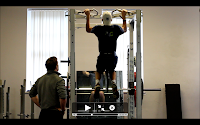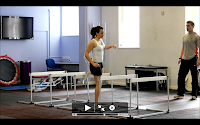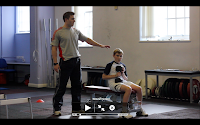
Friday, 28 May 2010
Thursday, 27 May 2010
Fitness Video
Recently i have been working on a fitness video with an english tennis association coach, its very interesting to do this as its completely different from previous work i have done. Its not exciting shots or any sort of visually intensive effects. I like the fact this is literally shoot quick edit done, money in the pocket.
He has hinted at more work in the future on a project which would be far more exciting, an animated mixed martial arts video........watch this space....




He has hinted at more work in the future on a project which would be far more exciting, an animated mixed martial arts video........watch this space....




Friday, 14 May 2010
Oh man
DIY DSLR Wooden Shoulder Rig from Jonathan Clifford Bergqvist on Vimeo.
This is love and engineering, shame i dont have a workshop full of tools or a highly skilled dad (sorry). The thing of interest is the methods of focus with the handle being a twister motion allowing focus .
SteadiCam
550D Canon T2i Camera Stabilizer from emmagination on Vimeo.
For £100 you don't expect that much, one of the best things (also a hindrance at times) is the lightness of the 550d/T2i. This means that its not as hard to weight on a rig like this designed for smaller cameras. I will seriously think about this seen as it looks to produce some nice effects.
Offset Shoulder Rig
$20 DIY DSLR Shoulder Mount Rig - Offset from emmagination on Vimeo.
I am unsure what to do about this due to how this seems to be an option which has parts which are easier to source locally, i think this may be a better option seen as i can aline the camera directly up with my natural eye-line.
DIY Shoulder Mount
DIY $20.00 Dollar Shoulder Rig Camera Support from emmagination on Vimeo.
For my 550d i want to make a shoulder mount, the price of buying one is too much for my current status. I began looking at homemade options and stumbled across this little cracker, i need to find a builders merchants or hardware store near by but when i have the parts away i shall go. This will begin my equipment store which i plan on building throughout my career.
Filming Techniques
Field of View
The Field of View (FOV) is the angle described by a cone with the vertex at the camera's position. It is determined by the camera's focal length, with the shorter the focal length the wider the FOV. For example, for a 35mm lens the FOV is 63 degrees (wide-angle), for a 50 mm lens it is 46 degrees (normal), and for a 135 mm lens it is 18 degrees (telephoto). A wide angle lens exaggerates depth while a telephoto lens minimizes depth differences.
Transitions
In film or video scene consists of a sequence of shots. Each shot is made from a different perspective and then they are joined together. The joining together of the individual shots to make a particular scene is accomplished through transitions.
The transition may be from one camera angle to another camera angle or from one camera to another camera. When you do transitions as a CG animator you are fulfilling the role of the editor, whose task is to put together a set of individual shots into a scene. One technique that film editors use is to focus on a particular element that is consistent between shots. This can be a physical object or it can be a compositional element such as a motion, color, or direction.
The simplest transition between shots it is a straight cut, which is an abrupt transition between two shots. Another type of transition is called a fade, in which the overall value of the scene increases or decreases into a frame of just one color. For example, a fade to black may indicate the end of the sequence. When one scene fades out as another scene fades in this is a dissolve. These dissolves are used frequently to indicate a passage of time. For example, you might have a shot moving down a hall and then a dissolve as it moves into a different part of the building.
Another type of transition is when one scene wipes across the frame and replaces the previous seen. Wipes can move in any direction and open one side to the other or they can start in the center and move out or the edge of the frame and move in. Wipes are very noticeable and best not used often.
Camera Angle
The camera angle helps to determine the point of view of the camera. This is very important since viewers have seen much TV or film and this has conditioned them to interpret the cameras "eye level" as containing meaning. Viewers expect the camera to show a level horizon. If the camera is not then it appears sinister to them. The cameras height above ground level and its angle in relationship to the ground should reflect real-life. A birds eye or worms eye view is unnatural and draws attention to itself. This may be all right if there's a reason. However, it may detract from the content of the animation. Something that is a problem in CG. is that the ease of moving or putting a virtual camera anywhere may lead to excessive use of inappropriate camera angles.
A good idea is to observe existing film and video and to determine how far above ground level the camera is for a particular scene and use that information. For example, in a wide-angle shot the camera is usually in position of a viewer sitting down. In close-ups males are usually shown from just below eye level and females from just above eye-level. Placing a camera at the eye level of a standing person actually appears too high most of the time.
Camera moves
There are several fundamental camera moves that were developed right after the invention of motion picture cameras and are still used today. Using a virtual camera you can make almost any move, however, it is still a good idea to use these real world moves. These moves include the following:
Panning and Tilting
For both of these shots the camera is stationary and rotates in a horizontal (panning) or vertical (tilting) plane.
Panning is used to follow a moving object or character, or to show more than can fit into a single frame, such as panning across a landscape. It is also used as a transition between one camera position and another.
Inexperienced operators may pan too fast and caused an effect known as strobing. This is also a problem in CG and is called tearing. This can cause motion sickness or cause the illusion of motion to be broken. For example, for an animation at 30 fps, the number of frames needed for a 45 degree pan would be about 22 frames for a quick turn or 66 frames for a casual turn.
One way to avoid strobing is to use scene motion blur when rendering. This blur is done by sharing information between frames. Note that this is a scene motion blur where a scene shares information from the prior and next scenes. This is not the same as object motion blur.
The same motion considerations about panning are valid for tilting.
Dolly and Tracking shots
A dolly is a small wheeled vehicle, piloted by a dolly grip, that is used to move a camera around in a scene. A dolly shot is a move in and out of a scene, i.e., the movement is parallel to the camera lens axis. A tracking shot is a movement perpendicular to the camera lens axis. The key to these shots is to have realistic motion. The motion can be judged by looking at how fast humans move and then how many frames it would take to realize this motion. Examples of motion at different speeds are given in the table below.
Miles per hour Feet per second Number of Frames to move 10 feet at 30 fps
Casual stroll 2 2.9 102
Average walk 3 4.4 68
Brisk walk 4 5.9 51
Average jog 6 8.8 34
Average run 8 11.7 26
All out sprint 12 17.6 17
Car 30 44 7
It is also important to have realistically smooth starts and stops in your shots.
Crane or Boom shot
This is when the camera moves up or down, as if it were on a physical crane. The same considerations for panning and tilting apply for crane shots.
Zoom Lenses and the Vertigo Effect
A Zoom lens has a variable focal length and so camera "moves" can be made without actually moving the camera. Professional cinematographers use the zoom very sparingly and generally prefer to move the camera. Amateurs love the zoom and can create some very nauseating motion by combining zooms and rapid pans. A zoom changes the angle of display so spatial relationships also change.
In the movie "Vertigo", Alfred Hitchcock took advantage of this feature to create a what is now known as the vertigo shot. This involves synchronizing the movement of the subject with the zoom so that the subject is always the same size, but the background changes.
Depth of Field Effects
Real cameras have a depth of field, i.e., only part of the image is in focus at anyone time. The depth of field is a function of the lens length with short lenses (wide-angle) having a large depth of field and telephoto lenses have a small depth of field. Many CG cameras have an infinite depth of field, i.e., everything is in focus, and this looks unnatural. More advanced CG systems have cameras that emulate real lenses this way.
One way to change the center of attention in a scene is to have one object, e.g., in the foreground, in focus, with the background out of focus. Then an object in the background is brought into focus, with the foreground object now out of focus.
The Field of View (FOV) is the angle described by a cone with the vertex at the camera's position. It is determined by the camera's focal length, with the shorter the focal length the wider the FOV. For example, for a 35mm lens the FOV is 63 degrees (wide-angle), for a 50 mm lens it is 46 degrees (normal), and for a 135 mm lens it is 18 degrees (telephoto). A wide angle lens exaggerates depth while a telephoto lens minimizes depth differences.
Transitions
In film or video scene consists of a sequence of shots. Each shot is made from a different perspective and then they are joined together. The joining together of the individual shots to make a particular scene is accomplished through transitions.
The transition may be from one camera angle to another camera angle or from one camera to another camera. When you do transitions as a CG animator you are fulfilling the role of the editor, whose task is to put together a set of individual shots into a scene. One technique that film editors use is to focus on a particular element that is consistent between shots. This can be a physical object or it can be a compositional element such as a motion, color, or direction.
The simplest transition between shots it is a straight cut, which is an abrupt transition between two shots. Another type of transition is called a fade, in which the overall value of the scene increases or decreases into a frame of just one color. For example, a fade to black may indicate the end of the sequence. When one scene fades out as another scene fades in this is a dissolve. These dissolves are used frequently to indicate a passage of time. For example, you might have a shot moving down a hall and then a dissolve as it moves into a different part of the building.
Another type of transition is when one scene wipes across the frame and replaces the previous seen. Wipes can move in any direction and open one side to the other or they can start in the center and move out or the edge of the frame and move in. Wipes are very noticeable and best not used often.
Camera Angle
The camera angle helps to determine the point of view of the camera. This is very important since viewers have seen much TV or film and this has conditioned them to interpret the cameras "eye level" as containing meaning. Viewers expect the camera to show a level horizon. If the camera is not then it appears sinister to them. The cameras height above ground level and its angle in relationship to the ground should reflect real-life. A birds eye or worms eye view is unnatural and draws attention to itself. This may be all right if there's a reason. However, it may detract from the content of the animation. Something that is a problem in CG. is that the ease of moving or putting a virtual camera anywhere may lead to excessive use of inappropriate camera angles.
A good idea is to observe existing film and video and to determine how far above ground level the camera is for a particular scene and use that information. For example, in a wide-angle shot the camera is usually in position of a viewer sitting down. In close-ups males are usually shown from just below eye level and females from just above eye-level. Placing a camera at the eye level of a standing person actually appears too high most of the time.
Camera moves
There are several fundamental camera moves that were developed right after the invention of motion picture cameras and are still used today. Using a virtual camera you can make almost any move, however, it is still a good idea to use these real world moves. These moves include the following:
Panning and Tilting
For both of these shots the camera is stationary and rotates in a horizontal (panning) or vertical (tilting) plane.
Panning is used to follow a moving object or character, or to show more than can fit into a single frame, such as panning across a landscape. It is also used as a transition between one camera position and another.
Inexperienced operators may pan too fast and caused an effect known as strobing. This is also a problem in CG and is called tearing. This can cause motion sickness or cause the illusion of motion to be broken. For example, for an animation at 30 fps, the number of frames needed for a 45 degree pan would be about 22 frames for a quick turn or 66 frames for a casual turn.
One way to avoid strobing is to use scene motion blur when rendering. This blur is done by sharing information between frames. Note that this is a scene motion blur where a scene shares information from the prior and next scenes. This is not the same as object motion blur.
The same motion considerations about panning are valid for tilting.
Dolly and Tracking shots
A dolly is a small wheeled vehicle, piloted by a dolly grip, that is used to move a camera around in a scene. A dolly shot is a move in and out of a scene, i.e., the movement is parallel to the camera lens axis. A tracking shot is a movement perpendicular to the camera lens axis. The key to these shots is to have realistic motion. The motion can be judged by looking at how fast humans move and then how many frames it would take to realize this motion. Examples of motion at different speeds are given in the table below.
Miles per hour Feet per second Number of Frames to move 10 feet at 30 fps
Casual stroll 2 2.9 102
Average walk 3 4.4 68
Brisk walk 4 5.9 51
Average jog 6 8.8 34
Average run 8 11.7 26
All out sprint 12 17.6 17
Car 30 44 7
It is also important to have realistically smooth starts and stops in your shots.
Crane or Boom shot
This is when the camera moves up or down, as if it were on a physical crane. The same considerations for panning and tilting apply for crane shots.
Zoom Lenses and the Vertigo Effect
A Zoom lens has a variable focal length and so camera "moves" can be made without actually moving the camera. Professional cinematographers use the zoom very sparingly and generally prefer to move the camera. Amateurs love the zoom and can create some very nauseating motion by combining zooms and rapid pans. A zoom changes the angle of display so spatial relationships also change.
In the movie "Vertigo", Alfred Hitchcock took advantage of this feature to create a what is now known as the vertigo shot. This involves synchronizing the movement of the subject with the zoom so that the subject is always the same size, but the background changes.
Depth of Field Effects
Real cameras have a depth of field, i.e., only part of the image is in focus at anyone time. The depth of field is a function of the lens length with short lenses (wide-angle) having a large depth of field and telephoto lenses have a small depth of field. Many CG cameras have an infinite depth of field, i.e., everything is in focus, and this looks unnatural. More advanced CG systems have cameras that emulate real lenses this way.
One way to change the center of attention in a scene is to have one object, e.g., in the foreground, in focus, with the background out of focus. Then an object in the background is brought into focus, with the foreground object now out of focus.
Subscribe to:
Posts (Atom)